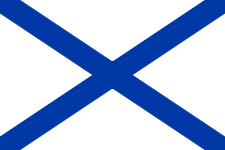Russian Navy Ensign
 | |
| Proportion | 2:3 |
|---|---|
| Adopted | 1712 |
The Russian Navy Ensign (Russian: Андреевский флаг; Russian Pre-reform: Андреевскій флагъ) was the ensign of the Navy of the Russian Empire (from 1712 to 1918), and is the naval flag of the Russian Federation and the banner of the Navy of the Russian Federation (since 1992).
The St Andrew's flag has a white background with two blue diagonal bands, forming a saltire, called St. Andrew's Cross. The ratio of the flag's width to its length is 1 / 1.5, the width of the blue band is 1 / 10 the length of the flag.
History

In 1698, Peter I the Great established the first Russian medal, the Order of St. Andrew, which is to be awarded for military exploits and public service. When Peter I became tsar, he started to devise a flag for the Russian Navy. The symbolism of the flag is a tribute to his father, Alexey Mikhaylovich Romanov who established a special flag for the first Russian naval vessel, the three-masted frigate ‟Eagle”.
From 1692 to 1712, Peter I personally drew eight flags projects that have consistently been taken into the Navy. Description of the flag's final version by Peter I:
| The flag is white, across it there is St. Andrew's blue cross, with which he baptized Russia. |
Original Text (Orthography and font (ru) are also original):
| Флагъ бѣлый, поперекъ этого имѣется синїй Андреевскїй крестъ, коимъ Россїю окрестилъ онъ. |
After the Russian revolution, the Russian Navy Ensign was changed, but it was used by the White Army up to 1924. The flag of St. Andrew was reintroduced in the Russian Navy in 1992, and is still used today.
Trivia
- In the Imperial Russian Navy, captains would finish encouraging their crews before combat with the words: ‟God and St. Andrew's flag are with us!” (Russian Pre-reform: «Cъ нами Богъ и Андреевскій флагъ!»), because the motto of the Russian Empire was ‟God is with us!” (Russian Pre-reform: «Съ нами Богъ!»).
See also
- Alexander Gordon (general)
- Patrick Gordon
- Thomas Gordon (Royal Scots Navy officer)
- Flag of Scotland
- List of Russian navy flags
- List of USSR navy flags
- Marsaxlokk, fishing village on Malta with a similar flag